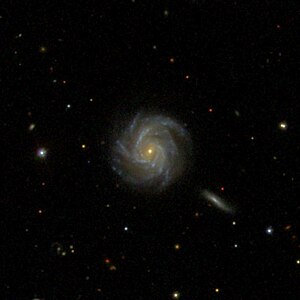NGC 6001
| Galaxie NGC 6001 | |
|---|---|
 | |
| SDSS-Aufnahme | |
| AladinLite | |
| Sternbild | Nördliche Krone |
| Position Äquinoktium: J2000.0, Epoche: J2000.0 | |
| Rektaszension | 15h 47m 45,9s[1] |
| Deklination | +28° 38′ 30″[1] |
| Erscheinungsbild | |
| Morphologischer Typ | Sc[1] |
| Helligkeit (visuell) | 13,7 mag[2] |
| Helligkeit (B-Band) | 14,4 mag[2] |
| Winkelausdehnung | 1,0′ × 1,0′[2] |
| Flächenhelligkeit | 13,6 mag/arcmin²[2] |
| Physikalische Daten | |
| Rotverschiebung | 0,033224 ± 0,000074[1] |
| Radialgeschwindigkeit | (9960 ± 22) km/s[1] |
| Hubbledistanz vrad / H0 | (450 ± 32) · 106 Lj (138,0 ± 9,7) Mpc [1] |
| Geschichte | |
| Entdeckung | Wilhelm Herschel |
| Entdeckungsdatum | 11. April 1785 |
| Katalogbezeichnungen | |
| NGC 6001 • UGC 10036 • PGC 56056 • CGCG 166-058 • MCG +05-37-27 • IRAS 15457+2847 • 2MASX J15474595+2838306 • GC 4143 • H III 371 • | |
NGC 6001 ist eine 13,7 mag helle spiralförmige Radiogalaxie vom Hubble-Typ Sc im Sternbild Nördliche Krone, die schätzungsweise 450 Millionen Lichtjahre von der Milchstraße entfernt ist. Sie bildet zusammen mit der etwa 465 Millionen Lichtjahre entfernten Galaxie PGC 56051 (welche gelegentlich falsch als NGC 6002 identifiziert wird) eine optische Doppelgalaxie.
Das Objekt wurde am 11. April 1785 von Wilhelm Herschel mit einem 18,7-Zoll-Spiegelteleskop entdeckt, der sie dabei mit „vF, S, R, verified with 240 power easily“[3] beschrieb.[4]
Weblinks
- NGC 6001. SIMBAD, abgerufen am 22. Mai 2016 (englisch).
- NGC 6001. DSO Browser, abgerufen am 22. Mai 2016 (englisch).
Einzelnachweise
Auf dieser Seite verwendete Medien
Autor/Urheber: Sloan Digital Sky Survey, Lizenz: CC BY 4.0
The sky image is obtained by Sloan Digital Sky Survey, DR14 with SciServer.
Angle of view: 4' × 4' (0.3" per pixel), north is up.
Details on the image processing pipeline: https://www.sdss.org/dr14/imaging/jpg-images-on-skyserver/



